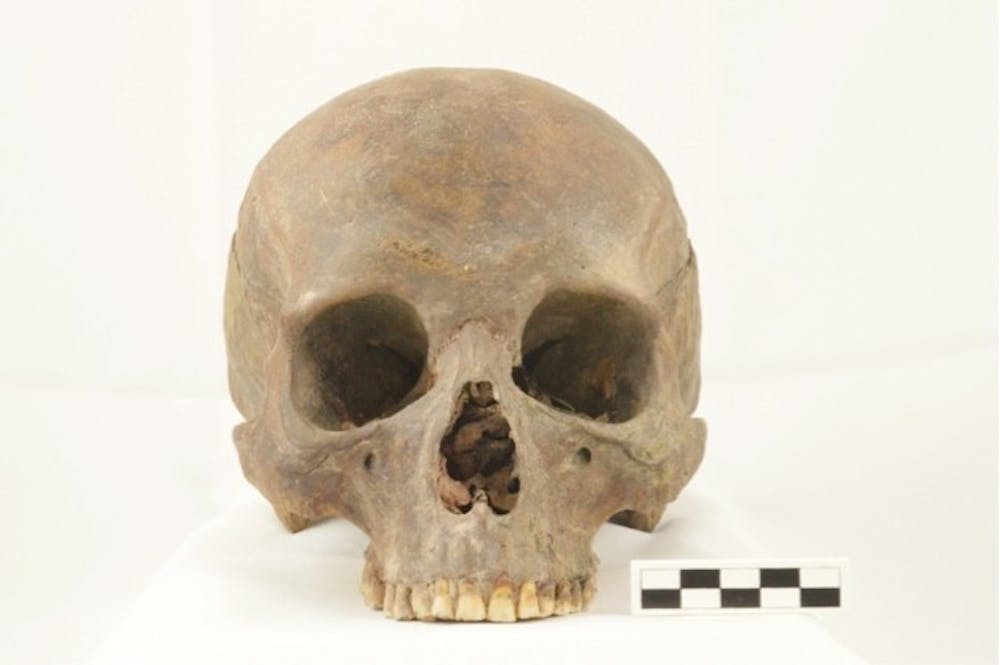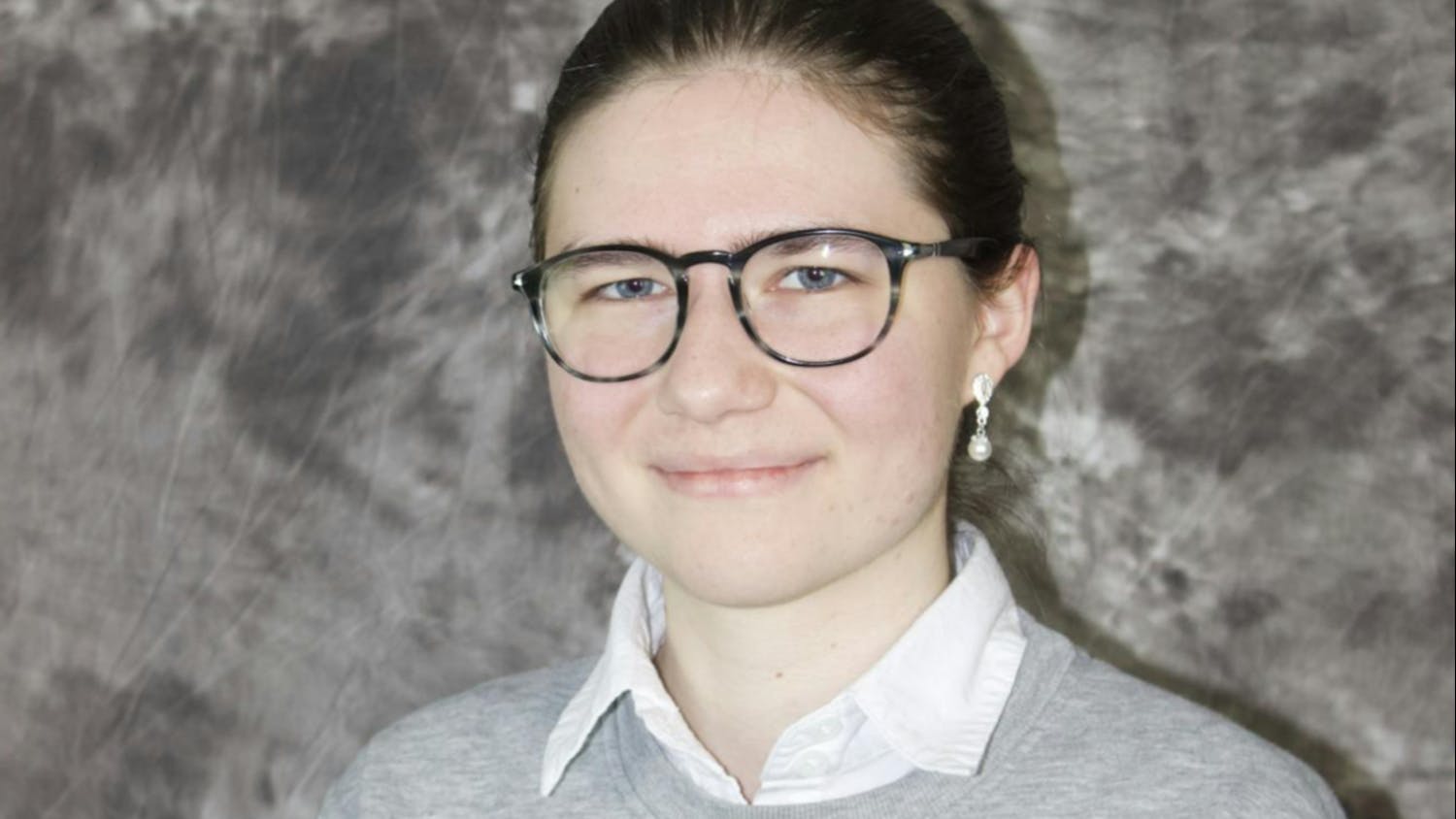Metal drawers line floor to ceiling in a room in the Department of Anthropology in the corner of Spaulding Hall. Glass jars lined up in rows sit nearby.
The drawers are filled with human bones. The jars? Human brains.
The remains – which include the bones of 380 people and close to 100 brains – are of those of residents of the Erie County Poorhouse, which once thrived on UB’s South Campus.
The poorhouse, or Erie County Almshouse, was a living facility for people who were struck by poverty and illness. The facility existed from 1850 until 1926 – 17 years after UB purchased South Campus in 1909 – and was neighbored by a maternity ward and an asylum, which still stand as Wende Hall and Hayes Hall, respectively, today.
UB’s Department of Anthropology conducted an excavation to recover the human remains underneath a construction site on Michael Road on South Campus in 2012 after numerous reports of bone discoveries on the campus had been made over the years.
Archeologists, which included UB students and professors, located 480 graves and about 380 bodies where the poorhouse’s cemetery used to be, and there are still an estimated 2,000 bodies in the area, according to Joyce Sirianni, a SUNY distinguished teaching professor of anthropology.
All of the remains are currently in Spaulding Hall and Sirianni said that are not currently any concrete plans for when the remains may be moved into a cemetery. The findings reveal the history of South Campus and its population before UB’s presence.
Bones, bones and more bones
Before the excavation project began in the summer of 2012, the Department of Anthropology had received numerous calls that human remains had been found when minor construction was done on South Campus.
“Workers would go out and dig a hole for a light standard and they’d run into bone,” Sirianni said. “Or any time they'd open up anything in that general area, they would find bone.”
Some small excavations were done in 2009, which are now included in the department’s collection, but the major excavation was in 2012. That’s when construction began on Michael Road, which is directly above the old poorhouse cemetery. It was then the Department of Anthropology knew it would have to get involved, Sirianni said.
New York State law mandates that archeological sites be located and artifacts or remains excavated before construction is begun. But these laws did not apply in this instance because the construction project involved replacement of existing infrastructure – not new construction, according to Peter Biehl, chair of the Department of Anthropology.
Douglas Perrelli, director of the UB Archaeological Survey of the Department of Anthropology, said the UB Archaeological Survey knew there would be a cemetery where the construction on Michael Road was planned and notified the planning board.
The Survey has worked in cultural resource management projects for over 35 years, Perrelli said. Archeologists from the Survey research and find historical evidence and archeological sites. UB archeologists have been excavating archaeological sites in Western New York and have investigated hundreds of historic and pre-contact sites in Erie County alone, according to Perrelli.
Going in
Unlike the excavation project in the summer of 2012, the previous accidental discoveries often disturbed the remains when they were discovered. Perrelli said the remains in the cemetery were exhumed so that they wouldn’t be damaged or destroyed by the construction project.
Perrelli, who had led the excavation fieldwork, was joined by 15-20 faculty members and graduate and undergraduate students.
He described the onsite conditions as “difficult” because that summer had been very hot and frequented by heavy rain events. The whole event was “brutal,” he said.
“We would go from 90 degree days to torrential downpours and flooding the site,” he said.
It was also difficult to get through the soil the bodies were buried in. The coffins were surrounded by clay soil, which is very greasy and slippery when wet, and when dry, cracks and is as hard as concrete.
Meanwhile, the team had to complete the excavation as quickly and efficiently as possible in order to allow the construction on Michael Road to continue.
Sirianni said based on the trend of the coffins and bodies found, she has made the assumption the bodies were laid out based on when the person died. There were, however, a few cases where two coffins were stacked.
Sirianni recalled one of her graduate students meticulously excavating the bones of a baby. The student, Kevin Knowles – now a Ph.D. student – had to handle the remains as delicately as possible because they were extremely fragile.
“There was a whole section of these infant and child burials,” Knowles said. “There was a number of them in a row and one of those could take as long to excavate as one or two adults because you had to be so careful.”
Mark Giangregorio, a recent physical anthropology graduate, also worked with Sirianni on the recovery project during that summer. Giangregorio had just finished his freshman year and requested the opportunity to help out after taking classes with Sirianni.
“It was a fantastic learning experience for me and one of the ways I really came to be comfortable with my knowledge of bones and teeth,” he said. “There’s nothing quite like a hands-on experience.”
Giangregorio’s main tasks included cleaning and organizing the bones. He said although the experience was enjoyable, the scent of water mixing with minerals from the bones and the earth “ruined the smell of the beach for [him] for a while.”
Following the onsite excavation on South Campus, Sirianni recruited 18-20 students to help with the cleaning process, which began in the fall of 2012.
At the beginning of that semester, Sirianni was instructing an undergraduate course called Paleopathology and with so many remains to be cleaned, she made the decision to allow the students to help with this task.
“I said, ‘We can read articles and we can have our seminar or we can go in the other room and clean bones,’” she said. “And then they actually got a chance to see some pathological situations.”
The students cleaned the bones with just water, a bucket, a sieve and a soft sponge. Sirianni said they would “just bathe it like you would a baby.”
Surprising discoveries
Sirianni said people in the early 1900s lived in the Erie County Poorhouse because they had no other place to go and it was either that or die in the street.
“The relief system was to go to the poorhouse,” she said. “Our relief system now is Medicare, Medicaid or Social Security – a number of social safety nets.”
Residents would receive food, beds, rooms and medical services. And if they passed away during their time at the poorhouse, they were buried at the on-site cemetery.
When the bodies were excavated, the faculty and students would often come across individuals buried with proper clothing, like a suit, shoes and jewelry.
Sirianni said they had come across one man who had been buried with a newspaper from the early 1900s. Genealogists later found a newspaper in the records that matched exactly the one found in the coffin, she said.
“It makes it very personal because someone’s great-grandmother could be associated with that,” Sirianni said.
For Knowles, who studies dental anthropology focusing on oral health and dental pathologies, the most shocking finding was the presence of dental restorations.
During the excavation project, Knowles would search for tooth caps, which often looked more “like stones or little pebbles,” because of time and decay.
Among these items, he had also discovered other oral components, like dentures and fillings.
“I assumed, perhaps wrongly, that this population would be marred by terrible oral health,” he said.
Knowles said dental restorations at the time were not necessarily cheap. Dentures, for example, cost a “week’s wages for a working man.” He said there is a possibility these individuals had received these dental treatments outside the poorhouse and happened to have fallen on hard times, which landed them in the poorhouse.
While construction workers have found bone fragments on South Campus since the late 1800s, according to Perrelli, the Department of Anthropology did not find the remains of human brains until 2012.
Sirianni said around March and April of that year, she had gone down to Florida when one of her graduate students emailed a picture of a brain to her. The brain had been recovered on South Campus.
She said that was the first time they realized an intact skull that had been buried could contain a brain within it.
During the excavation project that summer, the on-site workers recovered around 100 brains, which are now preserved in the Department of Anthropology.
Perrelli said it could be due to the fact that the soils were saturated and wet, which did not allow the human brains to completely dry up. The clay soil, which the coffins were buried in, could be a factor because it holds water in and keeps things moist year-round, he said.
“They had lives”
When an individual died at the poorhouse, he or she would be buried in the on-site cemetery and the grave would be marked with a stake in the ground.
At the end of the season, the poorhouse would retrieve all the stakes, which were marked with numbers and use them again for the next year, Sirianni said.
“Therefore, we don’t know who’s who,” she said. “We have the burial records, but we don’t know if this is Tom, Dick or Harry.”
Sirianni and her team looked into time of death and cause of death during their analysis, but were unable to assign names to the bodies, she said.
The analysis is currently complete and the Department of Anthropology is waiting to find out when the bodies will be reburied.
Laura Hubbard, UB vice president for finance and administration, and her team are currently leading the research on the re-burying of the remains in a local cemetery.
Part of this planning includes memorializing the individuals who were buried in the poorhouse cemetery and preserving this important part of Buffalo’s history, said university officials.
“We’ll never know who it is,” Sirianni said. “But the whole purpose was to do this with dignity. They were individuals. They ended up in the poorhouse cemetery, but they had lives.”
email: news@ubspectrum.com





